Home Organ
March 13th, 2020. What a day, that will surely live in infamy for the rest of our lives. The day the schools closed, the day the churches closed, the day the world shut down. When I had found out that all of our churches would be closed, I was stressed out. I had no idea what I was going to do in order to practice organ. Surely a piano could work, and before COVID I has used one, but there's still nuance about an organ that a piano can never provide. For starters, multiple manuals, and most importantly: a pedalboard.
March 14th, 2020. The afternoon of Saturday March 14th, my choir director and organ teacher, Scott Lamlein sends me and his other students instructions as to how to make a virtual organ - for home practice. He chatted about how easy it can be, and how much more fun it is to have the acoustic of a European cathedral, rather than your music room reverb. In my mind, I read the email and then said "why not?!". I decided to go down to my basement, and throw together a setup. On the bottom manual, was a Yamaha Clavinova CLP-570. This was helpful for one of two reasons: I only had two digital pianos, and two it was a full home kit, so it had the stand and three pedal setup. On top, was a Casio Privia PX-160. This setup worked rather well, given the size of the pianos. The only thing I had to adjust was the angle of the Casio - done easily through a couple blocks of wood. Threw the Casio's music desk on top and I had a usable console (shown right)!

It certainly took some work to get the software to work
fully with the instrument. Through a couple MIDI cables
(musical instrument digital interface), I was able to hook the keyboards up to a computer I had lying around, and started playing on the organ built for the Piteå School of Music, in Sweden (shown below). Specs list can be found here.
Overall, it had a GREAT sound, a great acoustic, and in all honesty, some pretty useful stops for practice. The most important thing - it had a second manual! I could finally begin working on larger scale and more complicated pieces of music. My one complaint for this system: the distance between the upper and lower manual was SO huge, it made jumps between manuals
Opus 1: Home organ
Piteå School of Music Organ

difficult. It also made thumbing down onto another manual virtually impossible. I ended up having to use my nose to hold out a note because I couldn't hold it with my hand and play on another keyboard simultaneously.
This system worked really well for a long time. I was able to resume taking lessons with my teacher Scott, and excitingly, I began playing at our noonday prayer service that we held during the first lockdowns (whenever wifi would cooperate).
July 18th, 2020. I was brought to a warehouse full to the brim with old organ consoles, pipes, and more. After a thorough tour of the warehouse, I ended up going home with an Estey 32 note pedalboard, and matching bench! To say I was excited was an understatement.
I had, however, misjudged how much work it would be in order to MIDI-fy this pedalboard. Each note on the pedalboard has ten contact wires. 5 of which go into the ground wire, and 5 of which go to the note wire itself. That means that there are 320 wires on the pedalboard itself, 160 of which go to
each note wire. In order to be able to connect each wire to the encoder board, I then had to strip all 160 wires, and test them. Testing them was a process in it of itself: I had to connect the ground to the negative end of a voltage tester, then put the end of a note wire to the positive end, and then play each pedal to see when the voltage spiked. Once that happened, I would label the note name, and octave (low, mid, high). 32 notes, times 160 wires, means I had to play each of the pedals roughly 5,120 times. Around a week or two later, I had labeled all of the notes!

Finally labeled all of the wires!

Grouped wires by octave!

Grouped wires by note and octave!
Then, using tools borrowed from Scott Lamlein which were borrowed from Ed Clark, I used molex connectors to connect each wire to the encoder board. That was a long process, because if you did it wrong, you not only wasted a molex connector, but you would have to cut it off in order to begin again. At the end of this process, I hadn't messed up much! Although... I wasn't able to have a high F# until Mr. Lamlein lended me another connector. In around 3 weeks to a month, I had a fully functioning pedalboard!
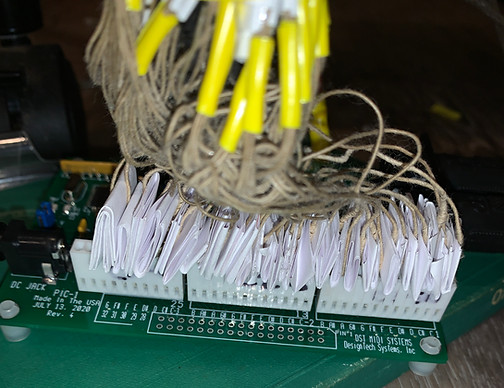
Troubleshooting the encoder
A simple piece of wood underneath the pedalboard became a quick fix. After completing this, I was ready to put opus two together (shown right)!
Because of where in the basement opus 1 was positioned, opus 2 ended up moving right next to the stairs, and is now in its own little nook!
Additionally, with this second opus, I decided to test out some new organs and found one that my teacher had been seriously using for a while. It is a wonderful french style organ in Austria, Friesach. This organ was a wonderful addition to the organ, with a long reverb, and very good sampling done by Piotr Grabowski. Specifications for Friesach can be found here.
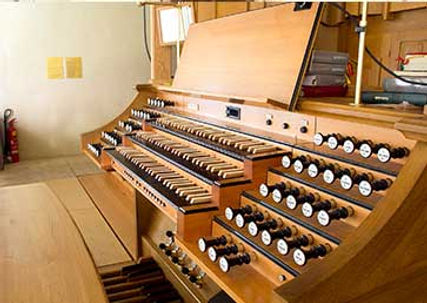
Friesach - Photo Credit: Piotr Grabowski
I say fully functioning as if it had no flaws or errors - trust me, it did. When I first connected the pedalboard, the instant issue was that multiple notes were being played - whether or not I was pressing any of the pedals down. Troubleshooting time: checking wires to see if they were touching each other, even shoved slips of paper in between the wires to ensure this (shown left), but the problem kept persisting. Then it was time to dig deeper, clean contacts, look at the underneath of the pedalboard - ensure the wires were fully sheathed the whole way run of the wire, but no dice. Started to think I might have to rip out all of the existing wires, on the board, and put in new wires using Cat-5E. In one last ditch effort, I upended the pedalboard looking through the wiring, trying to be absolutely sure of myself. Played a few notes, and found that there were no issues! Realized after then, that the contact rail of the pedalboard was seated too low on the pedalboard chasis, and that the contacts arked down too much. The rail was pushing the contacts together because of this.

Opus 2, pre-additions
This setup was great! I was now able to practice any type of repertoire, and lessons were going great (albeit over zoom).
With opus 2, I decided to add a few features, the largest of which was a new expression pedal bought from MIDI works. This finally brought in one of the nuances that my home organ was never able to provide. It certainly took time to get the swell pedal working, and it is still a daily struggle with how expressive the organ can be, but it is certainly helpful! I also decided to finally add a second screen - there were so many different menus, it became impossible to show them all at the same time. The second monitor solved this issue quickly!
I also ended up adding a microphone to the setup to make zoom lessons easier for music. Before, I had to switch the audio source between the microphone and the organ, but now I was able to have both audio inputs feeding simultaneously into zoom.

Opus 2, post-additions (no swell pedal at the time)
Practice with this setup was so much better than anything else available at the moment, especially with COVID raging on (although it was seeming to get better for a little while). This setup lasted a LONG time, for many months I was practicing on this instrument. Look below to hear opus 2 in action!
Singing Songs of Expectation
Praise to the Lord Almighty
The recording certainly makes the organ sound different than how it sounded in real life with the speakers. I had to turn on a bunch of the supercouplers in order to get a sound that wasn't completely muddy... that was a speaker problem to be solved later.
Current Problems:
1. Music desk is 1 million miles away, making learning of music difficult, and page turns difficult
2. Bad lighting, not able to see pedals at times, or able to see music
3. Distance in between keyboards is still very large
4. No very few implements for stop control
Time to solve those issues!
Through some bartering, I was able to trade my Yamaha Clavinova for a small casio keyboard. These casio keyboards are around a dime a dozen, but perfect for home organ setups! Then, I bought another Alesis V61 (61 note key controller). Through the help of my dad (and a saw) I ended up cutting parts of the casio off in order to be able to overlap the keyboards more effectively (see below).
Seems like a great fix no? I just solved the gap between the manuals, and got my Casio back for gigs!
Well... not exactly. When I was chatting with the friend I bartered with, I thought he had the matching music desk that went with the casio - turns out I was wrong.
Temporary solution for this was to add a THICK layer of gaffers tape to the edge of the new Casio for the music to rest on. It worked semi-well, but when you began to use the large hymnals or music books, the gaff tape would fail. So, I knew that opus 3 wouldn't be the final iteration.
So, I should probably go into a little detail about how the system is held up anyways. The keyboards were sitting on a computer desk that we just had laying around. The desk itself wasn't tall enough, so I had to "jack it up" using some wooden blocks that I had lying around.

A month or so went by, until I chatted with my Dad about the future of opus 3, and how we might be able to make a more permanent solution. Originally, I had thought of just making a music desk that could sit on the table, but my Dad had a different idea. Through some design plans, we came up with the design for opus 4 of the home organ - finally making its own frame.
It took quite some time, but it finally came together very nicely! Check out some pictures of the process!

Wiring electricity into the frame

Painting the frame!

More painting!
After around a month or so, and the LONG process of taking opus three apart, opus four was finally ready to be "unveiled".
Before and After

Opus 3
Pretty shocking transition huh?! You'll notice in the first opus 4 picture, there is no music desk. The music desk itself took some time to put together - but the end product is really great! The new music desk is lighted with dimmable LEDs, same as the pedalboard (see right).
Opus four was used in many different projects, recordings, virtual anthems (you'll notice the camera and two computers for recording. See the below video for a sample!
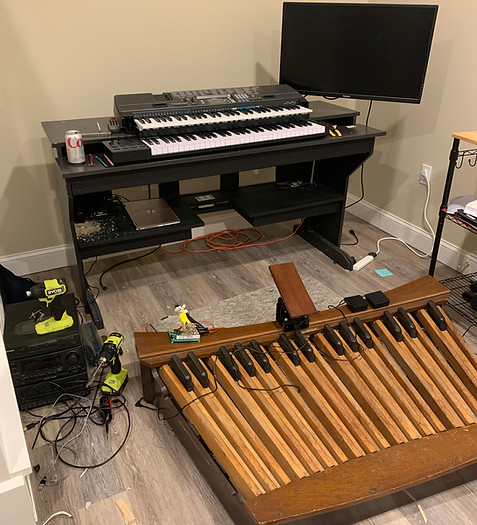
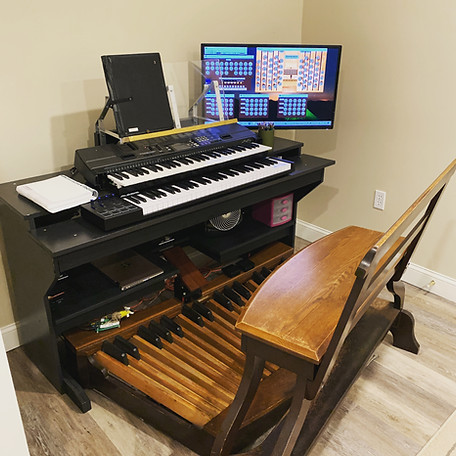
Opus 4.5 pre-new speakers
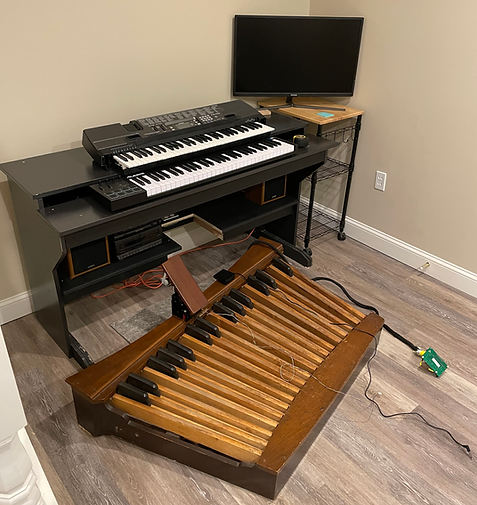
Opus 4

Friesach was setup in a really usable hymn setting/improv setting, with next and previous buttons on the pedalboard and using the drum pads on the bottom manual. I also had some speakers put underneath the organ on the shelf, with one on top. Eventually, I decided to change out the speakers for a smaller (but better quality) pair.
After a few months, I decided to take the organ apart one more time. I wanted to make the organ fully self contained. My goals for this project were:
1. Cable management
2. Computer inside organ
a. Really utilize the monitor
3. Power cable management
4. Fix music desk (the lights made page turns difficult)
Now, the organ is powered by ONE power cable into the organ rather than 6, the computer is inside, and cables are managed! It also now no longer needs the side-cart and effectively uses the second screen.
All in all, I am REALLY happy with how the current opus is.

Opus 4.5 post-new speakers
Thank you to:
In no order whatsoever!
-
Scott Lamlein
-
Brad Babbitt
-
Janet Babbitt
-
Bill Czelusniak
-
Ed Clark
-
Keith Thomas
-
Joe at DTS MIDI Systems
-
Piotr Grabowski
-
Classic MIDI Works
-
Music and Arts Avon


